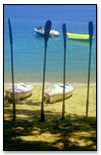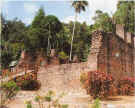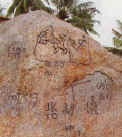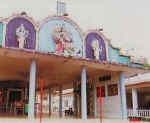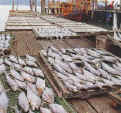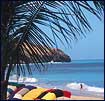|
| Consisting of nine islands, the two largest are Pulau Pangkor and Pangkor Laut. This popular island resort is largely inhabited by fisher folk living in scattered fishing settlements, especially on the eastern side. Their catch is comprised mostly of cuttlefish and anchovies. A wide range of sun and sea activities are available such as Scuba diving, windsurfing, fishing, and snorkeling.
Access is via a ferry from Lumut.
Location: 90Km SW of Ipoh, just off the coast of West Coast of Perak. |
| Moving Around
Buses and taxis are readily available on Pangkor for most part of the day. Should you decide for a more thrilling way to see the island, there are rental agencies that lease bicycles and motorbikes within the locality. Additionally, you can also rent for a cruise.
|
| Pangkor Town This is basically your one street town and with that one street being called the Main Street or Road. Here there are quaint coffee shops and souvenir shops. |
| Kota Belanda (Dutch Fort)
300-year-old foundations stones of a Dutch Fort built in 1670 represent what was once one of the Dutch strongholds against pirates and local Malays, this fort was abandoned after is was attacked by a local warrior, Panglima Kulab, and his followers.
In 1743, the fort was rebuilt and was made into a garrison for 600 Dutch soldiers.
Location: Pangkor Island. |
|
|
|
Batu Bersurat This large granite boulder has the inscription ‘1743 I.F.CRALO’ and the initials ‘VOC’ (Veerenigde Oostindische Compagnie (The Dutch East India Company), and the image of a tiger. The story behind it is that a child, who played by the rock, disappeared with no trace and was presumed that a tiger had taken the child. However the villagers said that it wasn’t the tiger that had taken the boy, but rather the angry Malays, who wanted to rid Pangkor of the Dutch. |
| The Dutch chiseled this incident on the stone depicting the Malays as a tiger. Location: A few metres from the Dutch Fort. |
| Kali Amman Temple The largest, and the only Indian temple of any significance on the island, it is noted as one of the two Indian temples in Malaysia that have the entrance the shrine of the goddess Kali, facing the sea. The other is located on Penang Island. The temple has a short staircase that descends to the sea where worshippers are required to cleanse themselves before entering the hall for worship. Location: Sungai Pinang Kecil. |
|
|
|
Sungai Pinang Kecil This quaint Chinese fishing villager offers a closer look at life of the average chines fisherman and his family. The fishermen's houses are next to the docks and when they return with their daily catch. The womenfolk are ready with knives and baskets to prepare their catch Their catch, which includes small and big fish as well as squid are then dried in the sun and later soaked in a sweet, spicy sauce. |
| The smell here however can be overwhelming, so those with sensitive noses and stomachs, should best avoid these places. |
Pangkor Malaysia Maps
Tours

|
|
